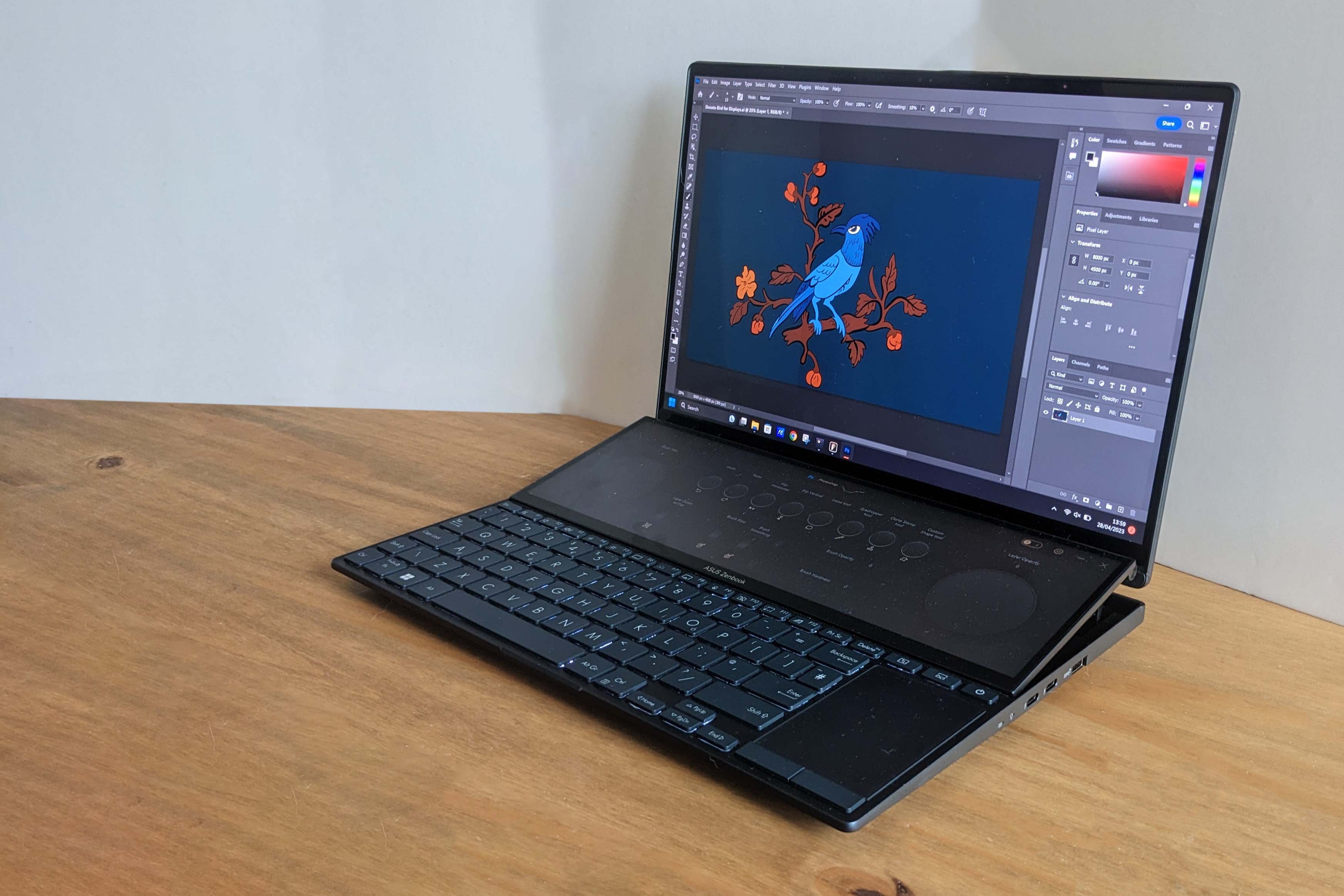
CPU: Intel® Core™ i9-12900H (14 Core)
Graphics: NVIDIA GeForce RTX 3050 Ti 4GB
RAM: 32GB DDR5
Screen: 14.5-inch 2880 x 1800 OLED at 16:10 aspect ratio
Additional Screen: 12.7” ScreenPad Plus 2880 x 864 IPS
Storage: 2TB SSD
Ports: 1x USB Type-A, 2x Thunderbolt, 1x HDMI, 1x 3.5mm Audio Jack, 1x DC-in, Micro SD card reader,
Size: 32.35 x 22.47 x 1.96 cm
Weight: 1.7 kg
The Asus Zenbook Pro 14 Duo OLED is aimed at on-the-go creatives, featuring a 2.8K resolution 14.5” OLED touchscreen and a 12.7” Screenpad Plus, effectively giving users a second half-monitor. The ScreenPad Plus comes with several extra features, including custom control-surface setups for several Adobe Products.
The Asus Zenbook Pro 14 Duo OLED costs £2,299, putting it alongside the HP Envy 15 (£1,999) and the Dell XPS 15 (£2,649) in the OLED market. OLED screens are particularly suitable for animation and graphic design due to their high levels of colour accuracy and ‘true blacks’ – check out our guides to laptops for animation and laptops for graphic design for more details.
I spent a week with the Asus Zenbook Pro 14 Duo OLED, trying out its features and putting it through its paces. I initially found the unique layout weird and a bit off-putting, but then it clicked. I’m a convert – the mini second screen is definitely a functional change to the classic laptop design, and I’m here for it.
Asus Zenbook Pro 14 Duo OLED review: Build
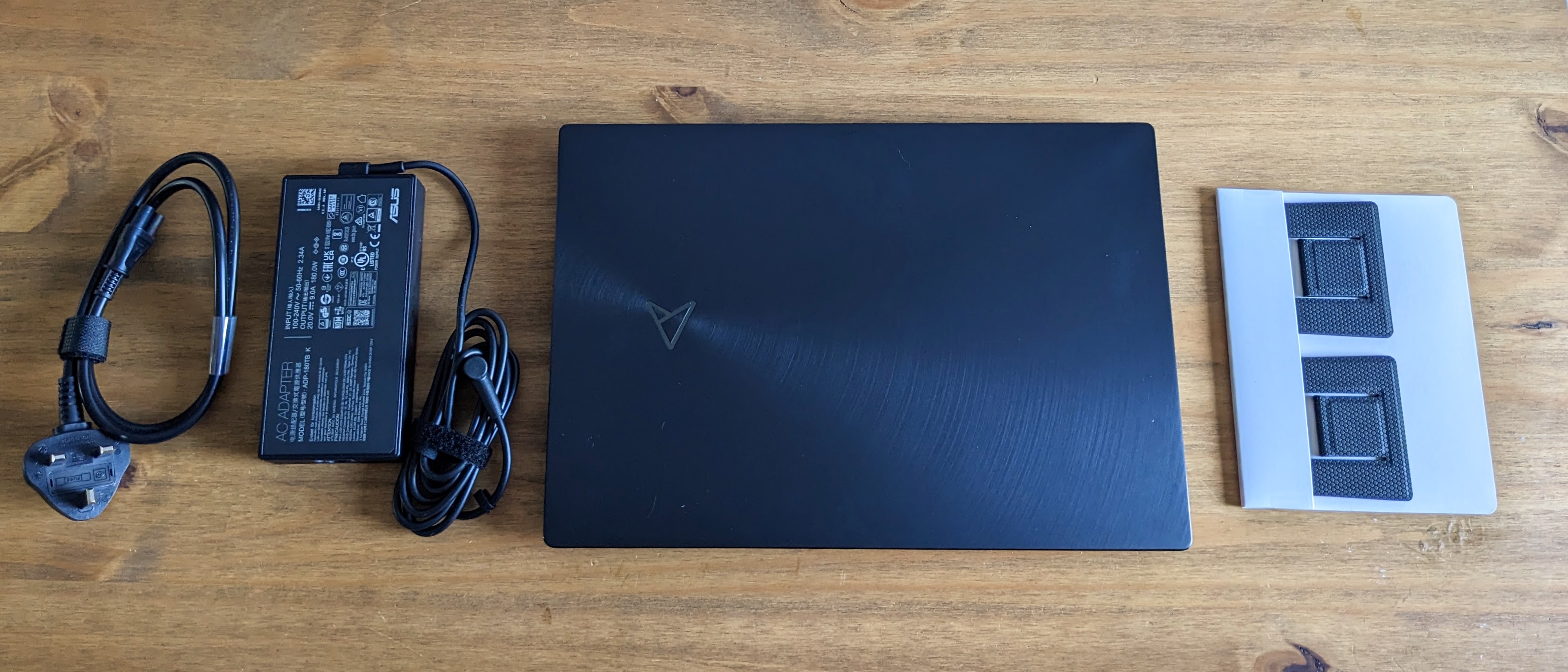
The Asus Zenbook Pro 14 Duo OLED might not look particularly groundbreaking when it’s closed, but it does have a certain style to it; it’s an all-metal build (weighing in at around 1.7kg) with some very stylish engraving on the lid, and plenty of ports (which is useful, as many users are going to want to opt for an external mouse). The power and HDMI ports are both on the back of the laptop rather than the sides as is common these days; this is one of the many signals that this is a laptop more suited to a desktop than a lap.
Screens. Yes. Plural.
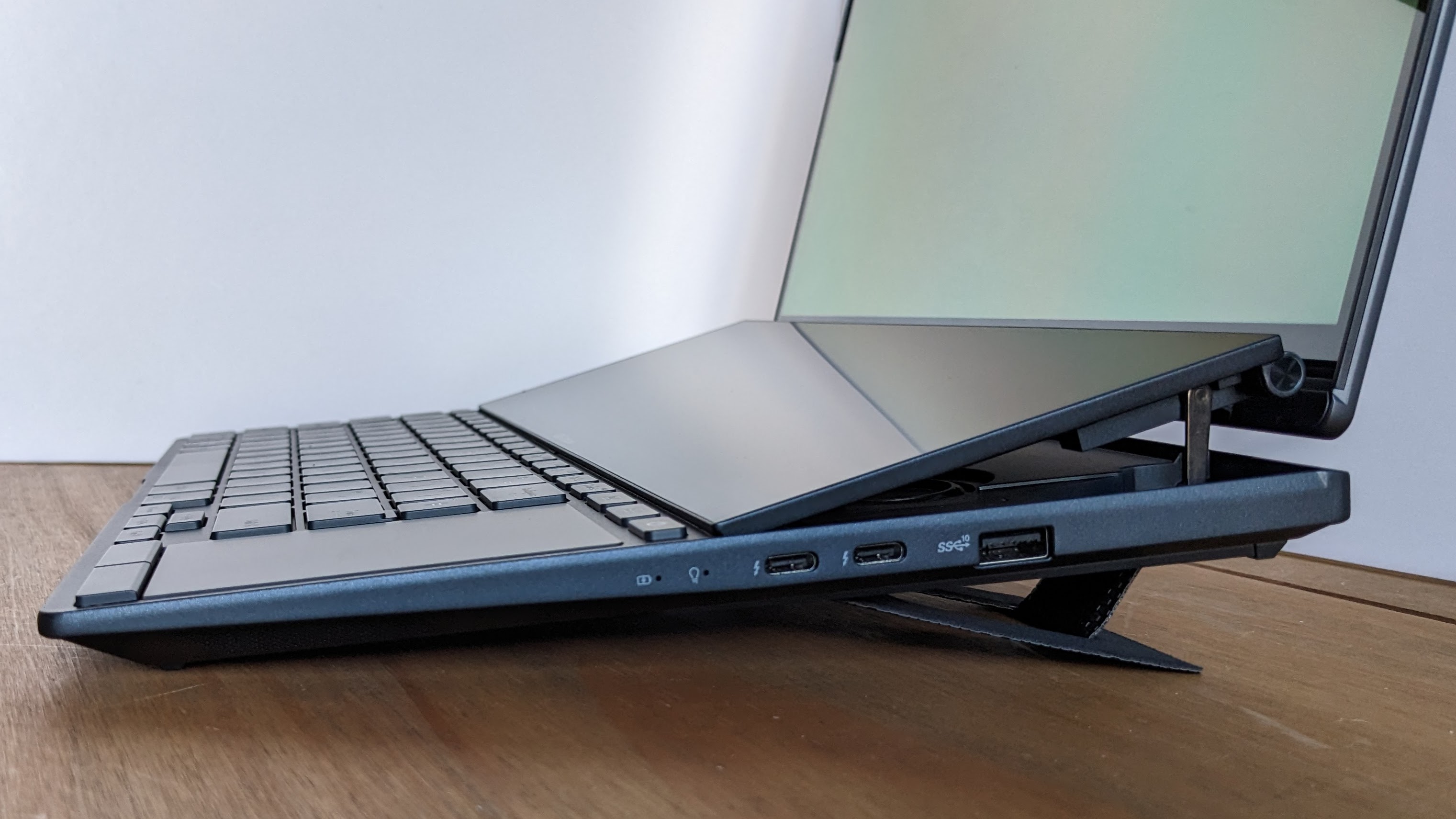
The Asus Zenbook Pro 14 Duo OLED is proud of both of its screens, and it has a right to be. I’m going to cover both, starting with the big ‘ordinary’ screen, although not that much is ordinary about it. To start with, it’s a slightly different aspect ratio to the norm, at 16:10, giving it a bit of extra height that I love. The OLED screen is also a beauty; darkness is darker, bright colours are richer and the Asus Zenbook Pro 14 Duo’s OLED screen is even Pantone validated. It boasts a 2.8K resolution, which is lovely to look at (but does impact battery life), and its refresh rate of 120Hz is smooth as silk. The touchscreen is responsive and easy to use; it’s just a pity it wasn’t bundled with a compatible stylus.
And then on to the additional screen, which is the first thing you notice when you open the laptop. I love a second monitor; in my day-to-day life I feel a bit lost with a single screen, so the addition of a second half-screen on the Asus Zenbook Pro 14 Duo OLED is a game changer for me. It’s lifted off of the chassis at a 12-degree angle, allowing for additional airflow and making it easy to view, and has an anti-glare coating that honestly I’d love to be added to more screens generally, which combats the ceiling-reflection issue that was present in the previous model.
One of the downsides of the Screenpad Plus is that it is a drain on the battery, with battery life lasting around four hours with it on and around six and a half with it switched off. It’s easily switched off via a key just below the Screenpad Plus; unfortunately, the model I received arrived with the Screenpad Plus switched off and it took me a while to figure out the problem (jumping to the more complicated assumption of out-of-date drivers or software issues rather than just ‘it’s switched off’) until eventually I hit the button by chance. Idiot-proof it is apparently not.
It’s also surprisingly easy to use once you’re comfortable with it; over the past week, I’ve used it for WhatsApp, picture references, app controls and also for viewing my character sheet in a remote TTRPG session. The two screens are easy to drag between but occasionally require a little tweaking when it comes to sizing; the Screenpad Plus often initially shows browser windows very zoomed out, which is off-putting but easy to remedy.
It’s clearly designed with the creative in mind; there are several inbuilt settings for different Adobe apps, (Photoshop, Illustrator and Premier Pro, although disappointingly not Audition), but one of the other elements in which it really shines is its customizability – I’ve long been a convert of customisable control units such as the TourBox, and the Asus Zenbook Pro 14 Duo OLED basically allows you to turn its entire second screen into a customisable control panel, speeding up and optimising workflow. Personally, this is revolutionary; when audio editing on the go, I tend to carry around multiple extra control surfaces, so the ScreenPad Plus virtually eliminates the need for them.
Keyboard and touchpad
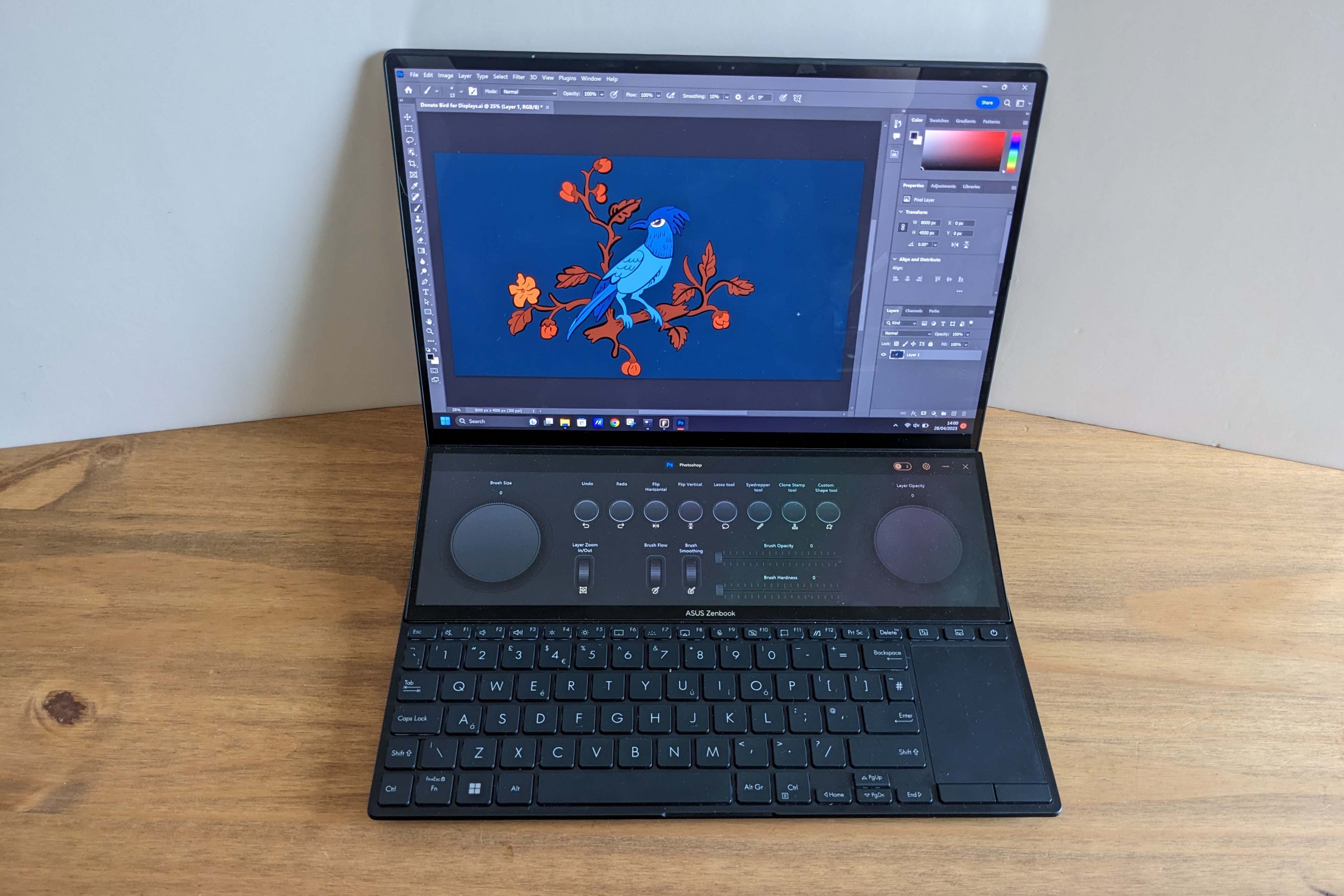
Unfortunately, where there’s innovation, there is also sacrifice, and the sacrificial lamb in this particular case is in the standard user inputs. To fit the Screenpad Plus into the Asus Zenbook Pro 14 Duo OLED, the keyboard and touchpad have been scrunched down to the bottom of the laptop, removing all vestiges of a wrist rest and pushing the touchpad to the right – a move making the laptop far less practical for anyone who is lefthanded.
The keyboard is more compressed than normal, leading to typing mistakes, and the lack of any wrist support meant that when using it on my lap I had to bend my wrists into awkward angles to type. The touchpad is very small, although responsive, and I was pleasantly surprised to have keys for left and right clicks. I personally feel that it should probably have been bundled with a mouse.
Video and audio
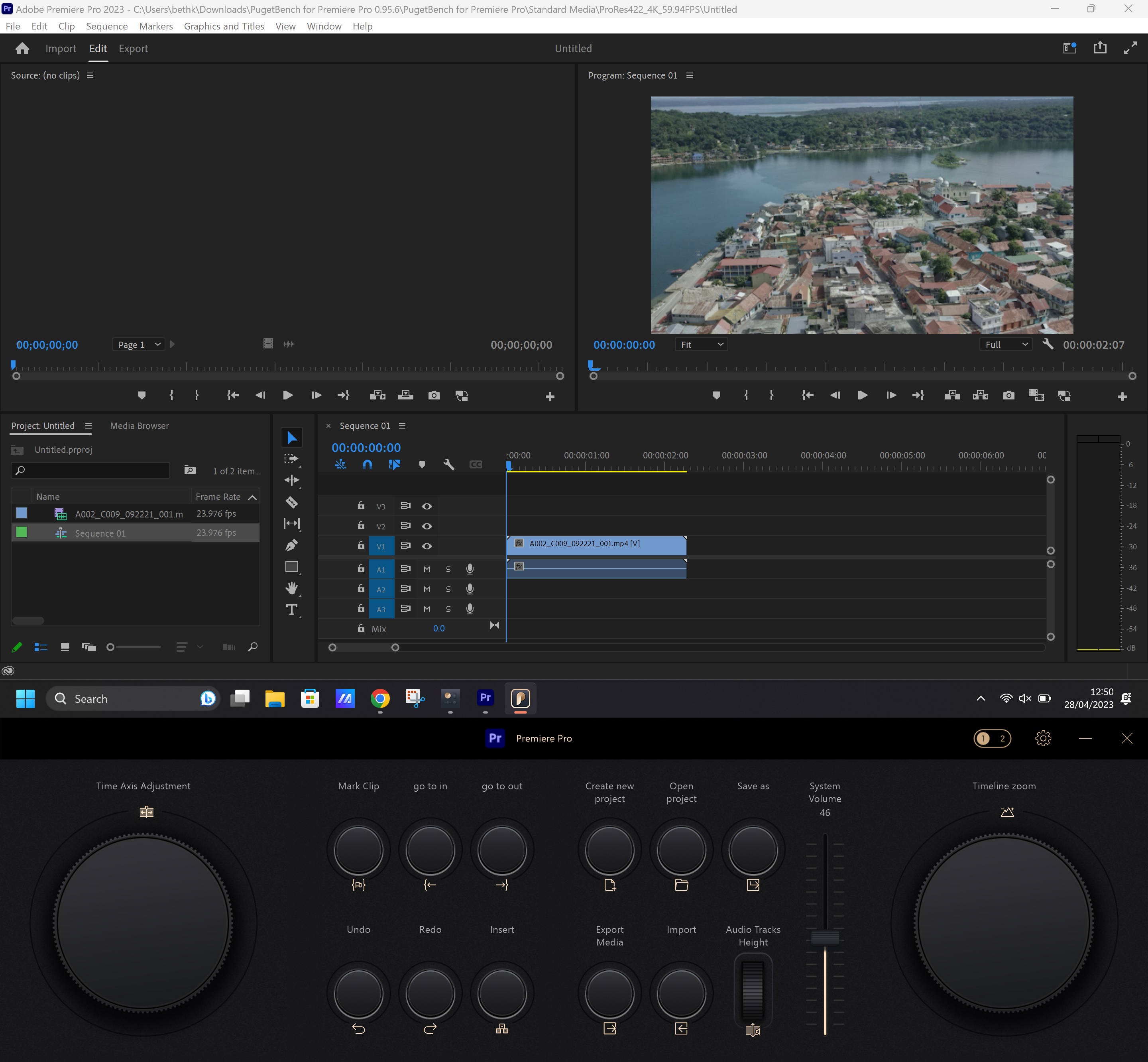
The Asus Zenbook Pro 14 Duo OLED has a fairly ordinary microphone and webcam setup; the webcam does an okay job and the mic is pretty good (‘mics’ might be more appropriate; it features a four-mic array with inbuilt AI noise cancellation).
One of the elements that Asus is very keen on highlighting is its stereo sound system from Harmon Kardon, using Dolby Atmos technology. The speakers are big and impressively loud, but unfortunately their placement is their downfall; they’re stuck behind the Screenpad Plus, which muffles the sound and limits high-frequency sounds (but does accentuate the stereo separation).
This means that the Asus Zenbook Pro 14 Duo OLED hasn’t got the tinny problems of your standard laptop speakers: it actually suffers from the opposite effect, with the treble being heavily suppressed, leading to a dark, dull sound. There is notable bass, but it’s not what you’d get from full-range speakers, and while you can turn the volume up loud, you can actually go slightly louder than the speakers can handle; they start to distort at full volume.
As with all laptops, you get the best sound quality when the laptop is on a solid surface and the worst when it’s on a soft surface.
Software
The Asus Zenbook Pro 14 Duo OLED comes bundled with the standard irritating Windows bloatware, including a persistent set of aggressive popups from McAfee and the usual round of ‘free’ software that turns out to be a trial and require a debit card. When cleared, it operates smoothly and cleanly, opening apps without any significant waits.
Performance

Cinebench R23 Multi-core: 15,002 points
GeekBench 6: 2,251 (single-core); 12,301 (multi-core)
PCMark 10 (Home Test): 7,149 points
PugetBench Photoshop: 972 points
PugetBench Premiere Pro: 831 points
The Asus Zenbook Pro 14 Duo OLED is certainly a workhorse, and a portable one at that; it’s incredibly fast thanks to its i9 processor and 32 GB RAM, and its 2TB storage is probably enough for the creator on the go.
I didn’t notice any real slowdown or hanging when working on projects, and the benchmarking scores agree with me, with PCMark 10 ranking the Asus Zenbook Pro 14 Duo OLED highly at all levels, with a rendering and visualisation score of 13,519. In addition, on the PCMark 10 website, the Intel Core i9-12900H Processor is ranked second of all laptop processors for April 2023.
Should I buy the Asus Zenbook Pro 14 Duo OLED?
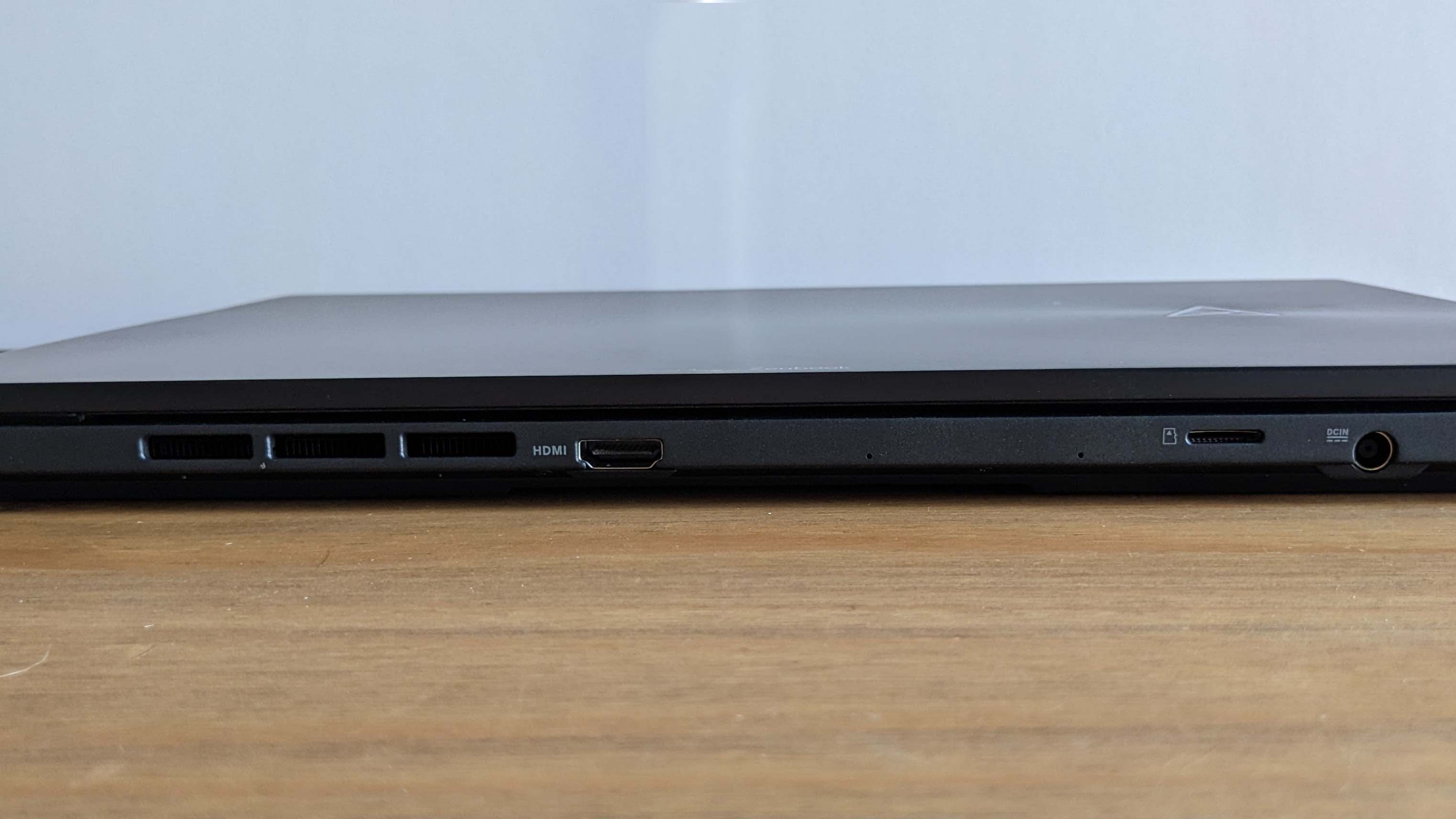
One of the key things about the Asus Zenbook Pro 14 Duo OLED is that there’s nothing out there quite like it. Quite aside from the customisable control elements available in Adobe apps and configurable for pretty much any other app on the laptop, even for everyday use, I found myself naturally gravitating towards the ScreenPad Plus. I even got fairly used to the minimal keyboard and touchpad (which was confusing when I switched back to a laptop with a standard, central touchpad).
If you have a clear use for the extra screen and its customisable control elements, this is the laptop for you. If you don’t, it’s an expensive gimmick and comes at the cost of a big reduction in battery life (the laptop runs for around four hours with the Screenpad Plus on and six to seven switched off). But if you’re working at a desk and have access to a power socket, neither of these things should be that big an issue.
At £2299.99, the Asus Zenbook Pro 14 Duo OLED isn’t the most affordable option, but its performance and extra screen make it a great choice for creatives looking for a mobile workhorse. If you’re not intending to take it around with you, however, a desktop with a double-monitor setup will inevitably be a more comfortable and configurable option.







